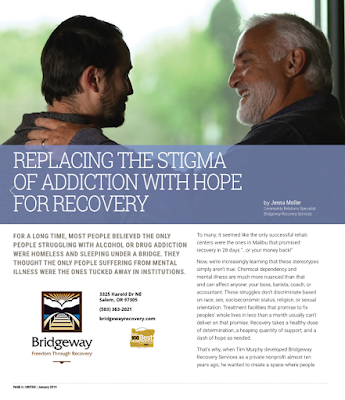Revised: 27 January 2019
By Sarah Owens and Michael Livingston
Revision reflects additional reasons for construction delay cited by Salem Reporter.
The City is seeking contributions in an effort to close the widening gap between the cost of operating a sobering center and the current financial commitments to cover that cost. See, Moller, J. and Murphy T. "Replacing the Stigma of Addiction with Hope for Recovery." (January 2019, Salem Business Journal.) (special section United at 6.)
In November, Bridgeway CEO Tim Murphy's estimate for year-round, 24/7 operation was $638K/yr, and the gap was around $200K. See "Sobering Center Sustainable?" His most recent operating-cost estimate is about a million dollars. Without additional commitments, that's a gap of about $.5M.
Not even urban renewal can close that kind of gap. (See "Urban Renewal to the Rescue.")
The City's difficulty in pulling together the funding necessary for sobering center has contributed to delayed construction of Phase 2 renovations to the Mid Willamette Community Action Agency (MWVCAA)'s building, where the sobering center is to be located. Phase 2 includes construction of a commercial kitchen, showers and laundry facilities for the homeless day shelter patrons, in addition to the sobering center.
Phase 1, completed last July, involved significant plumbing upgrades to accommodate the sobering center. Sunk costs are not, however, a sound basis for business decisions, and whether to proceed with the sobering center build out should be "a business decision", should it not?
The obvious question at this point is whether MWVCAA should proceed to construct Phase 2 without the sobering center, or with the sobering center, despite the gap in anticipated operating costs.
 |
| Jan 2019 United piece on Bridgeway |
At the end of the United piece on Bridgeway, readers wanting to support the sobering center are asked to contact Courtney Knox Busch at City Hall. Readers are told that
[s]ometimes, when people are struggling with addiction, they just need a roof over their head for one night before entering treatment.
But how substantial a connection is there between sobering services and entering treatment?
We asked Tim Murphy about the idea that, sometimes, people struggling with addiction to the point that they've ended up living on the streets "just need a roof over their head for one night before entering treatment."
Interpreting the question as asking for "figures about admissions straight to detox", he said he would look. We've spent some time looking, and, although Tim might be able to find something through his professional connections, we couldn't.
What we did find is that fear of being "dope sick" is a huge barrier to seeking treatment for addiction. So, any delay between the decision point and treatment, and lack of transportation, shelter, and safety also are huge barriers.
Maybe "a roof over their head for one night" can prompt someone living on the streets to make a decision, but whether s/he's able to make it into detox and treatment as a result would seem to depend on the program.
Not much is known about Bridgeway's sobering center program. MWVCAA doesn't provide any drug or alcohol treatment services. Neither does The ARCHES Project. As the City puts it, the sobering center program will only "connect individuals with treatment resources."
 |
| "City of Salem Efforts to Reduce Homelessness" |
On its website, the City touts the sobering center as an "effort to reduce homelessness". But, given the lack of evidence that sobering services lead to treatment, the sobering center would seem to have about as much to do with reducing homelessness as the failed sit-lie ordinance had to do with pedestrian safety.
The other reason the City gives for supporting the sobering center is "to relieve some of the burden on our regional hospital and jail." Assuming that's true, why aren't those entities willing to do more to close the gap on operating costs? (Marion County is contributing $100-150K/yr, Salem Health is contributing $100K/yr for a limited time, and, contrary to what's in the United piece, there are no other commitments, including WVCH, the local CCO that's probably not going to be around much longer.) Does their lack of contribution not suggest that the "burden" on those institutions isn't all that great?
It's been two years since Mayor Bennett announced his intent to open a sobering center in Salem. Since that time, despite considerable time and effort, the project has not come together, but instead, has delayed construction of a much needed community resource -- hygiene facilities downtown. Is this the best the City can do?
1/19/19 Update: the staff report on the sobering center for the Council Policy Agenda work session scheduled for 23 January 2019 states construction "could" delay opening until May 2019, and that the City of Salem's contribution is now $250K, up from the budgeted $200K.
No comments:
Post a Comment